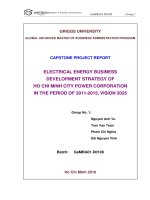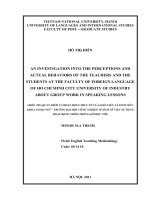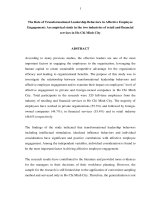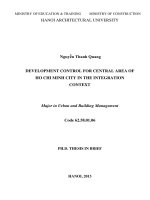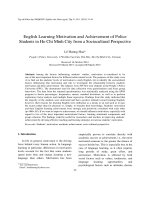IN INVESTIGATION INTO INTONATION AWARENESS OF TEACHERS AND STUDENTS AT FACULTY OF FOREIGN LANGUAGES AT INDUSTRIAL UNIVERSITY OF HO CHI MINH CITY
Bạn đang xem bản rút gọn của tài liệu. Xem và tải ngay bản đầy đủ của tài liệu tại đây (889.84 KB, 55 trang )
VIETNAM NATIONAL UNIVERSITY, HANOI
UNIVERSITY OF LANGUAGES AND INTERNATIONAL STUDIES
FACULTY OF POST- GRADUATE STUDIES
LƢƠNG MINH TI
́
N
IN INVESTIGATION INTO INTONATION AWARENESS OF
TEACHERS AND STUDENTS AT FACULTY OF FOREIGN
LANGUAGES AT INDUSTRIAL UNIVERSITY OF
HO CHI MINH CITY
((KHO ST S QUAN TÂM CA GIO VIÊN V SINH VIÊN TI KHOA NGOI NG
TRƢƠ
̀
NG ĐA
̣
I HO
̣
C CÔNG NGHIÊ
̣
P THNH PH H CH MINH)
M.A. MINOR PROGRAMME THESIS
Field: English Teaching Methodology
Code: 60140111
Hanoi, 2014
VIETNAM NATIONAL UNIVERSITY, HANOI
UNIVERSITY OF LANGUAGES AND INTERNATIONAL STUDIES
FACULTY OF POST- GRADUATE STUDIES
LƢƠNG MINH TI
́
N
IN INVESTIGATION INTO INTONATION AWARENESS OF
TEACHERS AND STUDENTS AT FACULTY OF FOREIGN
LANGUAGES AT INDUSTRIAL UNIVERSITY OF
HO CHI MINH CITY
(KHO ST S QUAN TÂM CA GIO VIÊN V SINH VIÊN TI KHOA NGOI NG
TRƢƠ
̀
NG ĐA
̣
I HO
̣
C CÔNG NGHIÊ
̣
P THA
̀
NH PHÔ
́
HÔ
̀
CHI
́
MINH)
M.A. MINOR PROGRAMME THESIS
Field: English Teaching Methodology
Code: 60140111
Supervisor: Dr. Nguyê
̃
n Trƣơ
̀
ng Sa
Hanoi, 2014
i
DECLARATION OF AUTHORSHIP
TITLE:
“An investigation into intonation awareness of students and teachers at Faculty of
Foreign Languages in Industrial University of Ho Chi Minh City.”
Name:LƢƠNG MINH TN
Supervisor’s Name: Dr. NGUYỄN TRƢỜNG SA
“I certify that this work is entirely my own and has not been accepted as part of a
submission to another purpose elsewhere”.
Signed:
ii
ACKNOWLEDGEMENT
Every researcher who conducts a study owes a debt to his supervisor, to his
counselors, to his respondents, to his friends, and to his supporters; I gratefully
acknowledge my deep indebtedness to all of them. First and foremost, my sincerest
thanks go to my supervisor, Doctor NguyễnTrườngSa, a great lecturer atFaculty of
Foreign Languages (FFL), in Industrial University of Ho Chi Minh City (IUH). He
has spent a lot of time guiding me through how to approach the research and how to
conduct it step by step with comprehensive instructions. He also spends his valuable
and limited time correcting my research and provides me with trustworthy
feedback. Hopefully, I have applied exactly what he has told me; in case I failed to
do so it was my fault. Secondly, I wish to express my particular thanks to
respondents and teachers who have supported me with all their heart. The data
collection is not without their support.
iii
ABSTRACT
The purpose of the research is to look at English teaching and learning at
tertiary education in Ho Chi Minh City. The university that I chose is Industrial
University of Ho Chi Minh City. The context makes me curious because it is still on
its newly-born development. During my teaching and practice at this university, I
have come to see that a lot of students find it difficult to use English, especially how
to speak it. One important factor that contributes much to speak English is
intonation. I have always seen a lot of students use English without intonation. But
more importantly, what is the cause of this? This research uses three research tools
to investigate the case: questionnaire, recording journals, and interview. The data
have been coded manually with the help of computers. The research has revealed
truths under the light of scientific research. With the results, the research has helped
both teachers and learners really improve their teaching and learning English
intonation. I refer readers to go chapter by chapter to fully comprehend what is
behind those results.
iv
TABLE OF CONTENTS
Declaration of authorship
Acknowledgements i
Abstract ii
Table of contents iii
List of chart, shape, extract iv
List of abbreviations vi
Chapter 1 Introduction 1
1 Reasearch background and problem 1
2 Context of the research 2
3 Research objectives 2
4 Research questions 3
5 Value of the research 3
6 Definitions of terms 3
7 Conclusion and overview of chapter 4
Chapter 2 Literature review 5
1 The nature of pronunciation 5
1.1 The definitions 5
1.2 Tones in intonation of spoken English 7
1.3 Theoretical and practical importance of intonation 8
1.4 English intonation acquisitions 9
1.5 Ways into intonation 11
2 Review of methodolody 13
Chapter 3 Methodology 15
1 Introduction 15
2 The research design 15
3 Ethical issues 17
4 The reason for choosing FFL, part of IUH as fieldwork 17
v
5 Pilot the research tools 18
Chapter 4 Results and discussions 19
1 Introduction 19
2 Students with their awareness of intonation 19
3 Students‟ recording journals 29
4 Teachers‟ interview 33
Chapter 5 Conclusions 36
1 Introduction 36
2 Essences of the research 36
3 Research strengths and weaknesses 37
4. Recommendations for future research 38
References 38
Appendixes I
Appendix 1 Questionnaire II
Appendix 2 Recording journals VI
Appendix 3 Interview VII
vi
LIST OF CHART, SHAPE, EXTRACT
Chart 1 Respondent‟s academic year 20
Chart 2 English learning important elements 21
Chart 3 Which is more important: stress or intonation? 21
Chart 4 Students‟ frequency of using intonation 22
Chart 5 Intonation challenges 24
Chart 6 Do you practice intonation at home? 24
Chart 7 Using of the internet to help you with learning English intonation 25
Chart 8 How do you often practice English intonation? 26
Chart 9 Students‟ self-correction 26
Chart 10 Do you learn intonation from your teachers? 27
Chart 11 Teacher‟s care 28
Chart 12 How do you get trained on English intonation? 28
Shape 1 How do you think intonation is important to you? 22
Shape 2 How do you think intonation is difficult to you? 23
Extract 1 Intonation for Wh question 29
Extract 2 Intonation for sentence reading 30
Extract 3 Intonation for correction 31
Extract 4 Intonation for listing 31
Extract 5 Intonation for short presentation 32
Extract 6 Intonation for role playing 32
vii
LIST OF ABBREVIATIONS
FFL Faculty of Foreign Languages
IUH Industrial University of Ho Chi Minh City
1
Chapter 1
Introduction
1. Research background and problem
The development of English has been so dramatic over the past centuries and
centuries beyond that Harmer (2006) called the language lingua franca. However,
the biggest question that has even been asked by generations and generations is why
a lot of students fail to interact effectively at workplace and even at interviews for
job opportunities. It is long believed that everything is there for reason; the same
goes for the situation being discussed. Chomsky (1980) ever addressed the terms of
competence and performance on discussing learner‟s learning ability. These two
terms also account for speaking skill learning and acquisition. Cook (2003:41)
points out that the formal systems of language consist of pronunciation, grammar,
and vocabulary. When linguistic competence is taken into consideration, three
above-mentioned areas of language seem to be placed at the center of language
teaching and learning. However, only knowing the systems is one basic aspect of
the invisible picture; another beneficial side of this picture may be hidden in
language learners‟ ability to make use of the systems and put it into spoken
language acquisition, especially that of speaking skill. When English-majored
students make their voice heard through their oral performance, we do not want to
admit this but they normally, in fact, have an obstacle in the path of speaking
English with variant pronunciation and sometimes even incorrect intonation
patterns. It is true that Pronunciation Course has been provided during their early
years at tertiary education. The course is a collocated combination of phonetic
training of sound systems, including minimal pairs (like /p/ and /b/ as in pin and
bin), stress (both at word level and sentence level), intonation patterns such as rising
tone, falling tone, level tone, fall-rise tone and so on as Baker (1993) and other
pronunciation text-book writers have put them onto the table for consideration; for
example, Mortimer (1996) and O‟ Connor (1967). In some other discussions,
2
Nunan(2006) and Hedge (2000) have also agreed that a student with good English
pronunciation could make him understood and get his meaning crossed easily.
However, in the light of this, it seems that these authors fail to address intonation
correction in relation to sharpening speaking skill. Then it becomes doubtful
whether it is required for students to be provided with intonation correction and
does intonation really play an important role in improving oral performance inside
and outside language classrooms? Can students be completely comprehensible
without being trained about intonation patterns? Scientifically, intonation correction
has not been much discussed; which leads to a potential fact, i.e. whether intonation
correction is one of the causes that leads to failure and corruption of English
speaking students. With that background and problem, the thesis has been carried
out.
2. Context of the research
Industrial University of Ho Chi Minh City was upgraded into a university from
a humble college known as Don Bosco for almost 10 years ago. Although the
school name sounds industrial; however, it includes a number of approximately 30
institutions and faculties which are about Tourism and Management, Bio
Technology, Food Technology, Environment, Electronics, Mechanics, Business
Administration, English and the like. The Faculty of Foreign Languages attracts as
many as 900 students and 30 teachers. Most of students come from rural areas and
are very studious with learning. The teachers follow pre-designed programs and
take turn teaching students. The training program divides into 2 main kinds: four-
year and three-year training programs. In the former program, there are students as
freshmen, sophomores, junior and senior. These students will be taken randomly as
samples for the research. The sample will also be discussed more deeply in chapter
three, Research Methodology.
3. Research objectives
3
The objectives of the research are to discover the awareness of students and
teachers in language classrooms about intonation and how this awareness has
helped them both to teach and learn English speaking skill.
4. Research questions
With the hope of understanding the tangible role of intonation correction, this
paper will also be used to answer the following research question:
Does intonation awareness matter to both teachers and students?
The research question will be solved through these three sub questions:
(1) To what extent do teachers take care of intonation correction as part of their
error correction and feedback provision in language classrooms?
(2) What is students‟ awareness of intonation as part of their learning English
for communicative purpose?
(3) What could be challenges for both the teacher and students in teaching and
learning English intonation as a foreign language?
5. Value of the research
The paper will be practically and scientifically valuable. For practical aspect, it
will grasp interest of those who are concerned with intonation correction yet fail to
have chance to search it in detail in a particular situation like Industrial University
of Ho Chi Minh City; for scientific aspect, it helps to find out what kind of role
intonation correction plays that text-book writers have not deeply considered yet.
6. Definitions of terms
Intonation
Intonation is one of the three major branches of the language with grammar and
vocabulary (Nunan 1999 143).
Intonation, as Nunan (1999) defines, is „raising and lowering your pitch to
convey aspects of meaning‟, he also adds that intonation is the „suprasegmental
aspect‟ of pronunciation.
Pitch
4
As Carter and Nunan (2001) points out, pitch is „voice height‟, and it depends
on the frequency of vibrations of the vocal cords.
7. Conclusion and overview of chapter
The first chapter of the research provides you with a short introduction of
research background and research questions, some key terms that you might want to
understand before reading the second chapter which deals with Literature Review.
Chapter three, which based on chapter two, will address the research methodology
and will also be the official tool for gathering data for analysis in chapter four.
Chapter five will continue the research with results, recommendations and the
research will end up with chapter six, the conclusion.
5
Chapter 2
Literature review
1. The nature of pronunciation
1.1 The definitions
Features of pronunciation mainly compose of segmental phonology, i.e.
individual sounds, such as minimal pairs like /bit/ and /pit/ and so on and supra-
segmental phonology, i.e. stress, for example, falling tone, rising tone and the like,
rhythm, and intonation (Nunan 1999 313). Pronunciation thus has been vitally
indispensable to teaching a foreign language in terms of spoken language (Cook
2003 41; Hedge 2000 119; Kumaravadivelu 2006 67; Nunan 1999 42). Factually,
pronunciation has recently gained more and more awareness from both language
learners and teachers. The matter of pronunciation, as described by Nunan (1999)
above, is divided into two types: segmental and supra-segmental phonology. Both
categories will be thoroughly considered as follows.
Pronunciation
Pronunciation, according to Nunan (1999), is „the ways in which sounds are
produced‟ (Nunan 1999 313). In English, it is commonly known that there are as
many as 12 monophthongs, 7 diphthongs, 24 consonants (O‟ Connor & Fletcher
1989 14). By pronunciation, we actually mean the ways sounds might be produced
through voicing organs of human beings. Another definition from Hedge (2000) is
that pronunciation is learner‟s ability to produce sounds that are intelligible to other
speakers (Hedge 2000, 268). Supra-segmental phonology which is part of
pronunciation consists of stress, rhythm, and intonation (Nunan 1999 313).
Stress
Carter &Nunan (1999) points out that stress refers to a particular syllable that is
pronounced louder with more energy and higher pitch for the sake of making it
prominent from other syllables (Carter &Nunan 1999 226). It is thus a part of supra-
segmental phonology, together with pitch, rhythm, tempo, voice quality (Carter
6
&Nunan 1999 227). Carter &Nunan (1999) also claim for the stress system. This
system of stress is the way in which lexical stress is fixed within an utterance
(Carter &Nunan 1999 9). They further state that in languages such as Spanish and
Japanese stressed is located at fixed distances from the boundaries of words;
however, in languages such as English and Arabic the main stressed is pulled
towards an utterance‟s focal syllable. Obviously, there are two main kinds of stress:
word stress and sentence stress.
Rhythm
As Carter &Nunan (2001) has pointed out, English is a stressed-timed language
(Carter &Nunan 2001 61). In other words, that could be understood as the fact that
„stressed syllables occur at regular intervals of time however many unstressed
syllables intervene‟ (Carter &Nunan 2000 61). In another chapter of the same book,
Carter and Nunan (1999) has also considered rhythm part of paralanguage, together
with pitch and intonation (Carter &Nunan 1999 203). Later in the book, they
consider rhythm the sequence of strong and weak elements in language, such as the
patterns made up by stressed and unstressed syllables (Carter &Nunan 1999 225).
They divide rhythm into two types which are trochaic (strong-weak) rhythm and
iambic (weak-strong) rhythm (Carter &Nunan 1999 9).
Pitch
On their discussion about pitch, Carter &Nunan (2001) point out that pitch is
the height of voice (Carter &Nunan 2001, 226). It is the vocal cords that create
vibrations which help make voice height. To make it clear, in the chapter written
about pronunciation, Carter &Nunan (2001) agree that pitch change is the speaker‟s
voice going up or down (Carter &Nunan 2001 58). As Roach (2000) suggests, pitch
is described as high and low (Roach 2000 150). However, he adds that only those
that are linguistically meaningful should be considered (Roach 2000 150). For
example, when someone is riding a horse, his voice might be high which is not very
linguistically meaningful.
Intonation
7
What is intonation? The answer to this question could never be satisfied (Roach
2000 150). However, Roach (2000) mentions the fact that intonation, to some extent
or perhaps most extent, has a strong relationship with pitch (see the definition
above) (Roach 2000 150). Carter &Nunan (1999) define intonation as the „use of
pitch to convey different kinds of meaning in discourse‟ (Carter &Nunan 1999 223).
They also mention the term intonation groups which are, according to their point of
view, „chunks of spoken discourse‟ and that this serves listeners as „signals of
organization and are characterized by pitch change on the most important syllable‟
(Carter &Nunan 1999 224). Intonation groups are also known as sense groups or
tone units. Also, in another book, Nunan (1999) proposes that intonation is by
means of lowering or raising voice pitch to convey aspects of meaning (Nunan 1999
307); for that reason, it is one of the supra-segmental aspects of pronunciation.
1.2 Tones in intonation of spoken English
Tone and tone languages
In Mandarin Chinese, for example, the word has different meanings depending
on which tone is used (Roach 2000 154). If we wished, we should take the word ma
for instance. If we have a falling tone when we say this word, it will probably
means „scold‟, but if it is spoken with level tone it means „mother‟ and the like.
Languages such as the above are considered tone languages. As far as we concern,
Vietnamese is also a tone language. However, English, as we all know, is not a tone
language (Roach 2000 154). For that reason, there is a big gap between Vietnamese
and English in terms of using tones to convey meanings and express someone‟s
thought. Obviously, the word tone has become much more complex than just rising
or falling. We might take a closer look at tone and tone units in the next part.
Tones, types, and functions of tones
Tone units, or intonation groups, are chunks of language that we have discussed
above. There are a variety of tones in English which could be used by speakers to
convey different types of both intended and unintended meanings. They are: falling
tone, rising tone, fall-rise tone, and level tone (O‟ Connor & Fletcher 1989 18).
8
Falling tone
Falling tone normally means more or less „neutral‟ (Roach 2000 155). This tone
is also used to emphasize a „finality‟ of a statement or a sentence; in other words,
there is nothing more to be expected to hear from a falling tone. This will be
considered deeply as follows.
Rising tone
Rising tone, as Roach (2000) describes, plays an important role in suggesting
that something more to follow (Roach 2000 156). If someone say „Excuse me‟ then
with a rising „Yes‟, the conversations could suggest us that the second speaker
expects the first speaker to say something on their head or something that they
intend to speak. Not only that, the rising tone has been adopted in some
circumstances below.
Level tone
Roach (2000) defines level tone as something we are trying to sing on steady
note (Roach 2000 152). The function of level tone is to express the feelings of
someone who is uninteresting and boring. For example,
1.3 Practical and theoretical importance of intonation
Intonation together with stress is part on pronunciation (Carter &Nunan 2001
56). As far as we know, the role of pronunciation is:
the production and perception of the significant sounds of a
particular language in order to achieve meaning in contexts of
language use
(Carter &Nunan 2001 56)
It is because of the fact that intonation makes up pronunciation, it shares some
roles with pronunciation. We will take a close look at such roles: practical
importance and theoretical importance of intonation.
Divide a discourse into ‘units of information’
According to Taglicht (2008), intonation has the function of breaking a
discourse into tone units, or chunks of meaningful language and then intonation will
9
structure these units by separating anything from the whole thing that is considered
„new‟ to listeners (Taglicht 2008 213-230). With this role, intonation clearly helps
listeners to know before-hand which is new and which is given to them. Thanks to
that role of intonation, listeners are advantageous in understanding others and
making themselves across too. By contrast, without intonation, it is very
challenging for listeners to read up what the speakers said. That might be because of
the truth that chunks of language will be very much harder to understand then small
and comprehensible groups of words.
Position ourselves in personal and social lives
Intonation helps us to position ourselves in personal and social lives (Carter
&Nunan 2001 56). That is mainly because with intonation, we tend to feel what the
speakers intend to speak but he/she fails to express it out through words. There is a
good saying in English that goes „If you want to understand someone, you had
better try to understand the part that is not spoken.‟ That literally means that not all
the time we can read someone up thanks to verbal language. That is also why we
have paralanguage and extra-language. For example, when someone is angry, the
voice is expected to rise up with facial expressions and the like. The voice and
quality of voice can reveal a lot about how the speaker feels at the moment.
1.4 English intonation acquisitions
Halliday (1967) divides intonation into three „T‟s‟ which is tonality (the
chunking of speech into intonational phrases, or tone-units, tonicity (nucleus
placement) and tone (mainly, but not only: fall, rise, and fall-rise). From his
viewpoint we can see that acquiring intonation requires us to master three T‟s either
at the same time or one by one. Basing on whatHalliday (1967) says, Vietnamese
learners should have a lot of difficulty on tones. They hardly fall or rise in their
speech and many students speak the language without rising or falling their tone.
The question to be asked is what are the factors that could stop students from doing
so?
Factors influencing intonation
10
There might be a variety of factors that could influence intonation acquisition;
those main factors are usually the dynamics of intonation, lack of exposure to
English intonation, the current textbook treatments of intonation, and a missing
communicative focus of either the curriculum or the teachers. Each point will be
addressed at a time.
The dynamics of intonation
Carter and Nunan (2001) points out that early language learning could account
for being a good learner of pronunciation (Carter &Nunan 2001 61). This means
that with age, it tends to become much more difficult for someone to learn English
pronunciation and intonation as well. In other words, the older someone is the more
difficult for them to learn pronunciation and intonation of a language, especially a
foreign language. For that reason, learners should begin with intonation as soon as
possible.
Lack an opportunity for exposure to English intonation
Carter and Nunan (2001) have shown that students need an ample opportunity
for them to get as much exposure as possible to English intonation (Carter &Nunan
2001 60). Lack of opportunity also leads students to lack of perception of English
intonation (Carter &Nunan 2001 60). From their view point, we come to understand
that English intonation is very important but it will be useless if students are not
provided with a chance to master themselves in the field of English intonation.
Current treatments of intonation
In terms of teachers‟ feedback correction, it is very rarely for teachers to correct
students‟ pronunciation and intonation. This is true as Corder (1967). He reports
that teachers do not have enough detachment to evaluate learner‟s pronunciation.
That is also because of students‟ motivation and aptitude that might determine the
acquisition of intonation (Skehan 1989a cited in Carter &Nunan 2001 62). Other
factors are probably social attitudes, and personality factors (Carter &Nunan 2001
62). Apparently, current treatments of intonation are quite limited and for that
reason intonation awareness has not been paid a lot of attention to.
11
A missing communicative focus
According to Carter and Nunan (2001), „pronunciation moves from sound
manipulation exercises to communication activities‟ and they also add that „it
moves from a focus on isolated forms to the functioning of pronunciation in
discourse‟ (Carter &Nunan 2001 64). The same should go for intonation, i.e. it
should move from sound manipulation exercise to a communicative purpose.
Teaching English for communicative purpose is not easy at all; for that reason, the
focus on meaning has been hardly achieved.
1.5 Ways into intonation
Exposing to English intonation
For example, we can let students expose to non-native and non-standard
varieties of English (Wong 1987 2) The reason that leads us to this idea is that with
non-native and non-standard varieties of English, students will be able to recognize
the difference between native and non-native intonations. From that recognition,
they might learn something for themselves. Such intonation varieties could be taken
from radio broadcasts which are not spoken by native speakers but rather by non-
native ones.
Using the Internet
One very good way of mastering intonation is the use of the Internet (Carter
&Nunan 2001 64). Obviously, development of information technology has offered a
lot of important opportunities for learners to become more familiar with accurate
descriptions of language use. Nowadays, it is not difficult at all for students to find
CD, DVD, Multi CD-Rom and the like (Carter &Nunan 2001 64) on the Internet.
With a click on YouTube, hundreds or even thousands of videos teaching students
how to make use of intonation will be ready in a minute. One very famous teacher
of intonation and video learning is Mister Duncan from English. However, to make
this kind of learning useful, students are encouraged to learn on their own.
Autonomy
12
Autonomy is an important part of language learning and intonation acquisition
(Carter &Nunan 2001 64). However, students‟ autonomy is a great burden to
language education because many students do not really have a strong motivation
for their learning and for their jobs in the future (Hedge 2000 22). Hedge (2000)
states that such things as „anxiety‟, „attitude‟, or „willingness‟ will probably help to
shape the motivation for students when they learn a foreign language including
English. Of the three words, attitude may be the most important factor. With a
never-give-up attitude, students are more possible to get successful than those who
are still not clear of why they are studying English. This attitude cannot be achieved
easily; it is the part of teacher‟s encouragement and students‟ effort that count. Once
students are autonomous in learning, mastering intonation is just the matter of time.
Self-assessing
Assessing intonation is very crucial in student‟s life. The role of assessment has
been pointed out by Hedge (2000); he claims that assessment guide you towards a
greater awareness of your own assessment practices (Hedge 2000 406). Assessing is
also beneficial for those who do not have much time to go to class. After assessing
themselves, they can learn something from themselves and then move on. That is
everything we expect our students to have with them right when they are still here,
being on the chair of a high school student.
Being able to recognize and copy English intonation
Roach (2000) has shown us that it is very important for students to be able to
recognize and copy English intonation (Roach 2000 152). He also recommends
several options which are to listen carefully to foreign speakers and to talk in person
with them (Roach 2000 152). Nevertheless, Roach (2000) warns us that in case
students are not able to have as much exposure as they can to English intonation
through foreign speakers, then it becomes very hard and challenging for them to
learn English intonation (Roach 2000 152).
Making students aware of structure of tone units
13
Brazil (2000) states that all spoken English is made up of tone units (Brazil
2000 194). Every tone unit has a tonic syllable. A tonic syllable, according to Brazil
(2000) is the last prominent syllable in the tone units (Brazil 2000 195). These clues
suggest us that tone units are a very important part of learning intonation and they
should be mastered by students either intentionally or unintentionally. The structure
should be made clear in the next few lines by Roach (2000). The tone unit usually
has three parts: the head, the pre-head, and the tail (Roach 2000 165). In fact,
students are not to know these kinds of things, but we at least try to fix the situation
by making a little effort in making them aware of the structure.
2. Review of methodology
Before this thesis, a lot of researches have been done for the sake of broad
understanding and deep revealing the nature of intonation. In this part, some major
researches will be included for reviewing. Due to time constraints, this thesis will
not cover all previous researches. I refer readers to read more about this topic for
better and deeper understanding it.
Most of the previous researches have focused on learning and teaching
intonation, little attention has been paid to teachers‟ care and students‟ awareness.
That means that this research has been a central point in the big picture of intonation
out there. Let us dig deeper for this fact.
Chun (1988) from University of Texas has discussed the role of intonation in
communicative competence and proficiency. He mentions firstly, the role of
intonation and discourse, secondly, models of communicative competence and
proficiency, and finally the guidelines of intonation. Chun (1988) did not mention
how to acquire intonation in relationship with teachers and students‟ awareness.
Another research from Allen (1971) suggests how to teach intonation, from
both theories to practice. In comparison with Chun (1988), we see that Allen (1971)
has more concentration on students in learning English intonation, with outside
context. He recommends four main things in his research (1) focus on major
patterns, (2) difference between punctuation system and intonation system, (3)
14
intonation between isolated sentences and extended discourse, (4) teaching students
how to think in terms of delivering a speech with intonation attached to it. Though
Allen (1971) has suggested and even taught in detail how to use intonation, all those
things are just theoretical. He fails to mention the role of teachers‟ care by
correction and students‟ awareness by trying to use intonation both inside and
outside language classrooms.
As a word of summary, both above-mentioned researches and many others have
focused on how to teach intonation, they did not reveal or suggest or include the
awareness of students and teachers in teaching and learning intonation. So this
research once again will reveal the darkness and bring the truth which is the
awareness of learners and teachers in the course of learning and teaching intonation
out under the light of scientific research.
15
Chapter 3
Research methodology
1.Introduction
The research has been conducted for the purpose of investigating awareness of
students and teachers on the importance of intonation to learning and teaching
speaking skill. Previously, in the literature review discussed in chapter two, an
overview of theory of teaching and learning intonation has been addressed. This
part will go one step further on how the research can be done to more thoroughly
investigate the awareness in practice, or in a particular context: Industrial University
of Ho Chi Minh City. The next section will be responsible for the research design
(including the procedure of collecting data and the issue of analyzing the data to
ensure generalizability, validity and reliability), the ethical issues and the rationale
for choosing Industrial University of Ho Chi Minh City as fieldwork.
2. The research design
Sampling
In this part, four factors that are worth mentioning and will be taken into
considerations are: (1) the sample size, (2) the representativeness and parameters of
sample, accessing to the sample, and (3) the sampling strategy to be used (suggested
by Cohen, Manion and Morrison 2000: Chapter 4).
The sample size is not expected to be very large as this research cannot cover
all participants in a given time though I have always wanted to make a large-scale
investigation for the time being. As previously discussed, a number of thirty
students from the Faculty of Foreign Languages (FFL) in Industrial University of
Ho Chi Minh City (IUH) will be involved in the research to complete a
questionnaire mostly about their awareness of intonation.
In terms of representativeness of the sample, it is quite difficult to estimate
exactly because the number of English majored students of English in IUH could be
hundreds or so and this number seems difficult to be wholly accessed and measured.
Therefore, I will do the research on several classes and students, and teachers as
16
mentioned above. That number should be around thirty for students and four for
teachers.
For the part of accessing to the sample, the only matter that struggles this
research is the issue of time. Each semester at FFL lasts very shortly, especially the
course of Pronunciation. It probably lasts approximately 2 months. It seems to race
with time for observing the classes. I have prepared very carefully under the
pressure of time to deliver the questionnaires and conduct the interviews with
teachers.
The sampling strategy to be used is „non-probability sample‟ (see more in
Cohen, Manion, Morrison 2000: Chapter 4 and in review of methodology which is
mentioned in chapter two). Non-probability sample is made use instead of
probability sample because in the former (non-probability sample) the researcher
can purposely select a number of respondents to include or exclude (Cohen,
Manion, Morrison 2000 99). Due to restricted time, non-probability sample may
work better than probablility sample which requires every member of the wider
population to have an equal chance of being included as sample.
Questionnaire
There will be a couple of research tools to be adopted. The most important tool
is questionnaire. As far as we have known, questionnare is widely used and it is also
a useful way of collecting data. A number of 14 questions will be included in the
questionnaire. Those questions range from general to specific level, from awareness
of intonation used in and out classrooms, from teachers‟ role to students‟ role. I
refer the reader to the appendix for a closer look at the questionnaire which has been
composed basing on theory of research methodology suggested by Cohen, Manion,
Morrison (2000 Chapter 14).
Interviews and recordings
For recording journal, all six students will be asked to help by recording their
voices through some major types of intonation (see chapter one of the research). I
want them to do this to reveal the relationship between their awareness towards



